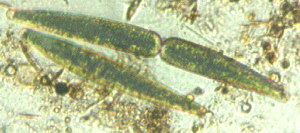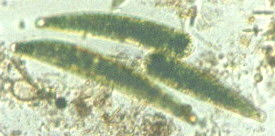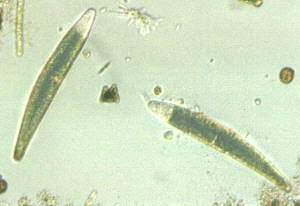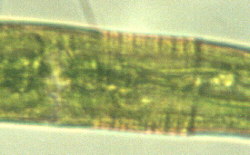Desmids
Multiplying by Dividing
by
William Ells
Coniferae, Walnut Tree Lane, Loose,
Maidstone, Kent, ME15 9RG, UK.
Most desmid cells of the order
Placodermae can be seen to be divided into two distinct
semi-cells; one of the exceptions is the genus Closterium.
This genus can often be found multiplying asexually by division.
| Fig .1 shows a cell in the
early stages of division where a constriction has formed
near the centre of the cell. The longest semi-cell is 210
mm. long the other 178 mm.
This constriction proceeds somewhat like the closing of
an iris diaphragm (Brook 1981). |
 |
 |
Fig.2 shows the two
semi-cells have parted. |
| Fig.3 shows the two new
cells nearing completion. |
 |
 |
Fig.4 shows the rings which form every
time division takes place, the length of this cell is 316
mm. width at its widest 38 mm. |
For a more detailed description of
Closterium division see The Biology of Desmids
1981 by Alan J Brook pages 104-108.
Comments and feedback to Bill Ells are welcomed.
© Microscopy UK or their
contributors.
Published in October 1998
Micscape Magazine.
Please report any Web problems
or offer general comments to the Micscape Editor,
via the contact on current Micscape Index.
Micscape is the on-line monthly
magazine of the Microscopy UK web
site at Microscopy-UK
WIDTH=1
© Onview.net Ltd, Microscopy-UK, and all contributors 1995 onwards. All rights
reserved. Main site is at www.microscopy-uk.org.uk with full mirror at www.microscopy-uk.net.



